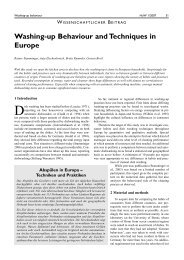Old Washing Machines Wash Less Efficiently and Consume More ...
Old Washing Machines Wash Less Efficiently and Consume More ...
Old Washing Machines Wash Less Efficiently and Consume More ...
Create successful ePaper yourself
Turn your PDF publications into a flip-book with our unique Google optimized e-Paper software.
Comparison Between <strong>Old</strong> <strong>and</strong> New <strong><strong>Wash</strong>ing</strong> <strong>Machines</strong> HuW 3/2005 125<br />
manufacture, the product identification code<br />
requires the manufacturer key on every single<br />
washing machine’s rating plate to be decoded.<br />
There is no direct link between a washing<br />
machine’s date of manufacture <strong>and</strong> that of its<br />
capacitor, but with all washing machines<br />
having a capacitor, <strong>and</strong> with every capacitor<br />
having to be removed before shredding, capacitors<br />
are the most reliable source of information<br />
concerning the age of a washing machine,<br />
providing that there is a correlation between<br />
the production dates of the capacitor<br />
<strong>and</strong> of the machine. This was proven for washing<br />
machines in which the dates of manufacture<br />
both of the machine <strong>and</strong> of the capacitor<br />
could be decoded (112 machines); in<br />
these cases the time difference was verified to<br />
be small (the average month of production<br />
being October 1987 in the case of the capacitors<br />
<strong>and</strong> November 1987 in the case of the<br />
washing machines). Thus, the capacitors’<br />
dates of manufacture (Fig. 1) were good indi-<br />
cators of the washing machines’ dates of manufacture. While<br />
the newest ones were only a few years old, the oldest<br />
machine found was almost 40 years old. With 1988 being the<br />
average year of manufacture, the machines were approximately<br />
16 years old at the time of disassembly. Assuming an<br />
interval of about one year between manufacture <strong>and</strong> original<br />
installation, <strong>and</strong> assuming another six months to pass bet-<br />
W ISSENSCHAFTLICHER B EITRAG<br />
Figure 1: Occurrence of capacitors in washing machines by year of manufacture<br />
of capacitor (n = 625); data collected between middle <strong>and</strong> end of<br />
2004 in Germany<br />
frequency of occurrence �<br />
60<br />
50<br />
40<br />
30<br />
20<br />
10<br />
0<br />
1960 1964 1968 1972 1976 1980 1984 1988 1992 1996 2000 2004<br />
Source: Own representation<br />
year �<br />
ween a washing machine’s end of use in a household <strong>and</strong> its<br />
being transported to a recycling plant, the average use-time<br />
of washing machines in Germany is approximately 14 years.<br />
The accumulated percentages by year (Fig. 2) show a characteristic<br />
lifespan of 17.5 years (at 63.2 % failure rate),<br />
while 20 % of washing machines have a lifespan of more<br />
than 22 years. As washing machine technology did not<br />
Vergleich neuer und alter Waschmaschinen:<br />
Trotz reduziertem Energie- und Wassereinsatz bieten neue<br />
Waschmaschinen bessere Waschwirkung<br />
Dass der Energie- und Wassereinsatz von Waschmaschinen sich in den letzten Jahrzehnten deutlich verringert hat, ist allgemein<br />
bekannt. Ob diese ökologisch und ökonomisch sinnvolle Reduzierung an Betriebsstoffen nicht auch mit einer Reduzierung der<br />
dafür erhaltenen Waschwirkung erkauft wurde, ist bisher nicht untersucht und ein wesentlicher Gegenst<strong>and</strong> der vorliegenden<br />
Arbeit.<br />
Zuerst wird aber berichtet, wie über eine Feldstudie auf Recyclinghöfen die Altersverteilung der Waschmaschinen zum Zeitpunkt<br />
ihrer Verschrottung gewonnen und daraus Rückschlüsse auf die Benutzungsdauer der Geräte im Haushalt gezogen wurden. Mit<br />
der Analyse der durchschnittlich erforderlichen Mengen an Wasser und elektrischer Energie für verschiedene Waschprogramme<br />
wird die notwendige Datenbasis geschaffen, um Vergleiche über die Entwicklung der Waschmaschinen der letzten 30 Jahre<br />
anstellen zu können.<br />
Da die Untersuchungen gezeigt haben, dass es viele Waschmaschinen gibt, die 15 oder gar 20 Jahre ihren Dienst tun, wird<br />
sodann experimentell untersucht, wie sich, unter heutigen Waschbedingungen, die Effizienz alter Waschmaschinen im Vergleich<br />
zu neuen Modellen darstellt.<br />
Überraschenderweise haben die Reduzierungen des Energie- und Wassereinsatzes nicht zu einer Beeinträchtigung der<br />
Waschwirkung geführt, sondern neuere Waschmaschinen bieten in der Regel sogar eine deutliche bessere Waschwirkung.<br />
Das Ergebnis kann zusammenfassend und vereinfacht wie folgt ausgedrückt werden: Um dieselbe Waschleistung wie in einem<br />
40-°C-Programm einer modernen Waschmaschine zu erreichen, muss in einem 15 Jahre alten Waschautomaten ein 60-°C-Programm<br />
benutzt werden, mit etwa dem doppelten Aufw<strong>and</strong> an Energie und Wasser, und bei einem 30 Jahre alten Waschautomaten<br />
ist der Aufw<strong>and</strong> für Strom und Wasser ungefähr viermal so hoch.<br />
Ökologische und ökonomische Konsequenzen aus den gefundenen Resultaten werden diskutiert.





